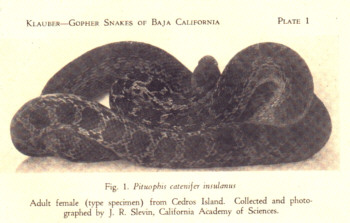|
Distribution |
|
This snake occure only on the island Isla de Credos off the northern Pacific coast of the mexican peninsular Baja California, in front of Guerrero Negro. The island is medium sized and has one town, two little airports and 2 havens. There are 2 mountains on Credos between wich is a forest. The credos island gopher snake can still be found there, but the Mexican law prohibits the export. There are no animals in privat stock known.
|
|
Description |
|
 |
It looks similar to the bimaris on the peninula. Because of its more than 50 (older lit.) (and 42-65, Grismer, 2002) black or brown bodysaddles it can be divert to the bimaris. To the other insular forms in the Pacific in front of the Baja California (Klauber,1946) sign up the folowing diferences: coronalis has diferences in the scalation under the eyes to ssp. insulanus. fulginatus has 2 dark parallel longitudoinal stripes under the tail, wich insulanus don’t has. Klauber, 1946 wrote down the maximum total lenght of 1400 mm for this ssp.. Only the scales in the middlerows of the back are keeled, on the sides the scales are smoth. Speciality in head scalation: 4 scales in front of the eyes (Prefrontalia). The snout scale is high as broad (Rostrale - Nasale 1:1) |
|
|
Habitat |
|
The Island Credos is a part is the Sonora desert, exactly the Vizcaino desert. This area is not completely dry because of moist air comes from the Pacific ocean and wets the landscapes in the morning. Because of this there grow a lot of vegetation compared to other desert. This snake behaves several habitats of this island, from the beaches up to the mountains, fom wildernes to behaved houses and their wasteplaces. |
|
Way of life |
|
?????? similar to the other Pituophis of the West coast? |
|
Diet |
|
In habitat this snake feeds mainly upon several sorts of rodents and birds.
|
|
Hibernation |
|
?????? similar to the bimaris? But in all month of the year there were founds of this snakes (Grismer, 2002).
|
|
Reproduction |
|
?????? similar to the other Pituophis of the West Coast? Some gravid females were found in June (Grismer, 2002)
|